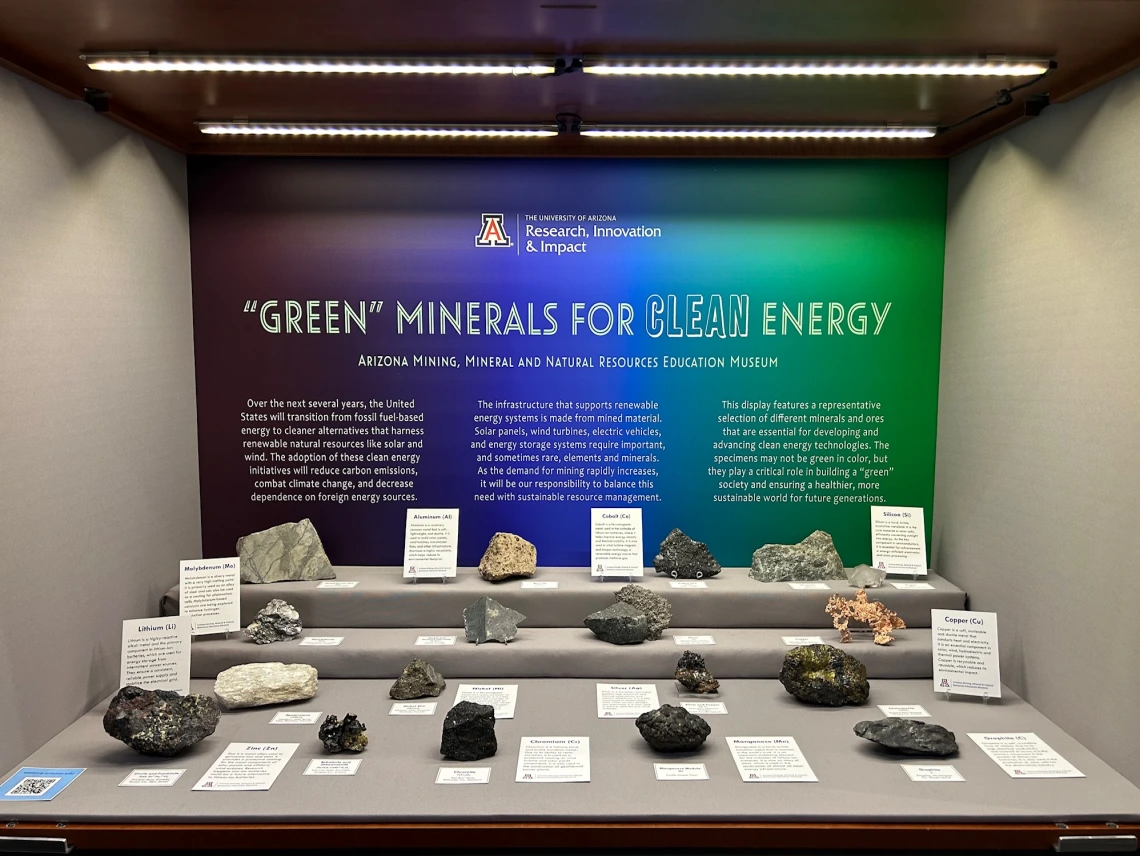"Green Minerals for Clean Energy": Our Special Exhibit at the 2025 Tucson Gem and Mineral Show!

Our case of green energy minerals and ores on display at the Tucson Convention Center during TGMS 2025.
We recently participated as a special exhibitor at the 70th Annual Tucson Gem and Mineral Show at the Tucson Convention Center, held from February 13 to 16, 2025. This year, the theme was “Shades of Green: Experience the Magic!” and instead of featuring green specimens, we chose to do an educational twist on the theme with different “green” minerals and ores needed to transition from fossil-fuel based energy to clean energy that harnesses renewable natural resources.
As you may know, the infrastructure that supports clean energy systems is made from mined material. Solar panels, wind turbines, electric vehicles and batteries all require important, and sometimes rare, elements and minerals and the demand for mining them will increase exponentially in the coming years. Our exhibit showcased a small selection of those minerals and ores, organized by native element: molybdenum, lithium, zinc, aluminum, nickel, chromium, cobalt, silver, manganese, silicon, copper and graphite. Each grouping included basic information about the element and how it is used for building clean energy infrastructure, with a representative specimen or specimens from either Arizona or North American-based localities. The only exception was a manganese nodule from the Pacific Ocean floor! Here’s what we shared for each element:
- Molybdenum (Mo): Molybdenum is a silvery metal with a very high melting point. It is primarily used as an alloy of steel and can also be used as a coating for photovoltaic cells. Molybdenum-based catalysts are being explored to enhance hydrogen production processes.
- Lithium (Li): Lithium is a highly-reactive alkali metal and the primary component in lithium-ion batteries, which are used for energy storage from intermittent power sources. They ensure a consistent, reliable power supply and stabilize the electrical grid.
- Zinc (Zn): Zinc is a metal often used to galvanize iron and steel. It provides a protective coating for the metal components of solar panels and offshore wind turbines. Research suggests zinc-ion batteries could be a future alternative to lithium-ion batteries.
- Aluminum (Al): Aluminum is a relatively common metal that is soft, lightweight, and ductile. It is used to build solar panels, wind turbines, transmission lines, and other infrastructure. Aluminum is highly recyclable, which helps reduce its environmental footprint.
- Nickel (Ni): Nickel is a ferromagnetic metal that resists corrosion at high temperatures. It is a key component in the cathodes of lithium-ion batteries, and an important alloy of steel. Nickel is also a catalyst in hydrogen production, particularly in water electrolysis systems.
- Chromium (Cr): Chromium is a lustrous, hard and brittle transition metal. Due to its ability to resist corrosion, it is used as a protective coating on wind turbine and solar panel components. It is also used in the construction of geothermal power plants.
- Cobalt (Co): Cobalt is a ferromagnetic metal used in the cathode of lithium-ion batteries, where it helps improve energy density and thermal stability. It is also used in wind turbine magnets and biogas technology, a renewable energy source that produces methane gas.
- Silver (Ag): Silver is a transition metal that exhibits high electrical and thermal conductivity and optical reflectivity. It is a key component in photovoltaic cells, which convert sunlight into electricity. It is also used in electric vehicles and wind turbines.
- Manganese (Mn): Manganese is a hard, brittle transition metal that is common in the earth’s crust. It is an important stabilizing element for the cathodes of lithium-ion batteries. It is also an alloy of steel, which is used in the construction of almost all clean energy infrastructure.
- Silicon (Si): Silicon is a hard, brittle crystalline metalloid. It is the core material in solar cells, efficiently converting sunlight into energy. As the key component in semiconductors, it is essential for advancement in energy-efficient electronics and data processing.
- Copper (Cu): Copper is a soft, malleable and ductile metal that conducts heat and electricity. It is an essential component in solar, wind, hydroelectric and thermal power systems. Copper is recyclable and reusable, which reduces its environmental impact.
- Graphite (C): Graphite is a soft, crystalline form of carbon. Due to its high electrical conductivity and layered structure, it is the primary component in the anodes of lithium-ion batteries. It is also used in the production of solar cells for the photovoltaic industry.
While most of the specimens weren’t green in color, the “shades of green” theme was a perfect opportunity to introduce some of the content that may be explored in our new museum and explore why mineral extraction is necessary for building a more sustainable “green” energy future. It was fun to see visitors reading the labels and taking photos, and as always, it was great to connect with our mineral museum colleagues and other friends of the museum. We’ll see you at next year’s show!





















